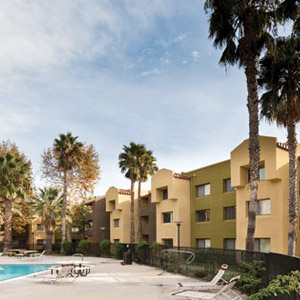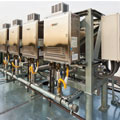
The original tankless water heater installation at Northridge took six weeks. More tankless installations at the university are currently in the works.
Beverly Watsoncan easily laugh about the idea today now that her recent tankless water heater retrofit project is complete and is fully meeting her requirements.
But Watson, the associate director of operations for California State University, Northridge, admits to wondering last summer while the work proceeded whether eight - as in eight tankless water heaters - were truly enough for her particular application.
“Frankly, to accommodate the water needs of each of our students, I thought we were going to need more than that number at each of the four residence halls we were upgrading,” she says. “So I kept asking the lead engineer on the project: ‘Are you sure we don’t need another tankless water heater or two?’”
Completed last August, the CSUN project entailed the complete removal and replacement of the original atmospheric boilers and storage equipment installed in the four 20-year-old student-apartment buildings. These rooftop systems provided not only domestic hot water to the residents of all four structures, but also space heating through a fan coil in each apartment.
The old boilers no longer had the ability to handle the hot water loads in an energy-efficient manner and could not meet the rigorous control standards of the South Coast Air Quality Management District.
In short, it was time for a new solution at the four buildings, each of which span three or four floors and house 37 to 52 individual living areas for two to four students apiece. The solution specified by Long Beach, Calif.-based P2S Engineering’sJames Valiensi, P.E., LEED GA, called for each apartment building to have its own multiple-unit Noritz America tankless water heater system. The eight units per building would furnish domestic hot water only, with a new and separate heat pump system handling the space heating.
During the design and installation process, Valiensi reassured his client that the proper sizing and engineering of the four new tankless systems would meet the demands of her intended application.
“I liked working for Beverly,” Valiensi says. “She’s very thorough, does a lot of research and asks a lot of questions because she wants things done right. She demands not only answers, but also documentation to support those answers. But like a lot of people, Beverly and her maintenance staff didn’t realize at first just how much hot water these tankless water heaters can deliver over a given time span.”
Two other individuals who did their homework on the CSUN project wereBryan Suttles, president of Suttles Plumbing and Mechanical Corp., and his project managerDan Boulais, who quarterbacked the installation. The final rooftop assembly at each building consists of four pairs of Noritz NCC199 condensing tankless water heaters mounted back-to-back in two rows onto a custom-made steel rack. Ruud series 14PJM split system 14 SEER heat pumps and RRHSLHM fan coils in capacities from 1.5 tons to 3 tons are in the dorm rooms and 4- and 5-ton Ruud Series RRPLB rooftop gas pack heating and cooling systems are used in hallways and public spaces.
Designed by the P2S Engineering team, including Pasadena, Calif.-based Wheeler & Gray Consulting Engineers, the racks can handle the required static loads and seismic forces in accordance with the California Building Code.
“Suttles Plumbing subsequently enhanced our design in the process of making it easier to build,” Valiensi notes.
The installer also decided against erecting these rack structures from scratch on the four rooftops. Instead, the Suttles Plumbing team chose to prefabricate them at its shop in Chatsworth, located just a mile-and-a-half from CSUN.
“Our proximity to the jobsite made this an ideal approach,” Suttles states. “We built the racks, fixed the water heaters to them, loaded the racks onto flatbed trailers and shipped them to the four jobsites. Once there, a crane hoisted the assemblies to the roof. All we had to do was fasten them onto the same rooftop platforms where the old boilers used to sit and connect them to the main piping. It all went very smoothly.”
This strategy significantly trimmed installation time.
“By avoiding the time and trouble of lugging all that material piecemeal up to the roof for assembly - water heaters, racking, piping, valves and fittings - we were able to cut our overall labor time in half,” Boulais says.

The installation of tankless water heaters in several student living complexes at Northridge has reduced energy costs by 60% in those buildings.
Clear-Cut Choice
The CSUN project started in July of 2009 when Watson commissioned P2S Engineering to do a feasibility study. Could the university simply replace the four existing boilers with up-to-date and more efficient models, thereby generating all the hot water the apartments needed, while also fully complying with SCAQMD restrictions?“We came up with several options,” Valiensi says. “The main alternative to a tankless solution was a boiler with a 200-gallon storage tank. At 8 pounds per gallon of water plus the structure to support it, the storage tank idea was not cost-effective. We would have had to launch a complete structural study and upgrade the building. Because of earthquake regulations, the engineering costs would have gotten really high.”
Suttles adds: “Tankless was the only practical option. The university would’ve had to restructure that roof to support the weight of any boiler-and-tank system.”
To finesse the weight challenge, Watson and Valiensi did briefly consider mounting the storage tank at ground level alongside the building. However, the university was not happy, for aesthetic reasons, with the prospect of creating a shed to enclose the tank, or with running pipe up the sides of the apartment exteriors or with building pipe chases on the inside.
“Tankless quickly became the frontrunner,” Watson states. “We decided to go as sustainable as we could and save as much energy as possible with the new water heating system.”
Watson began visiting HVAC and plumbing product trade shows to talk with manufacturers of tankless water heaters. She also followed up on their referrals to a couple of recent tankless installations - one commercial and the other residential - to see how they were performing.
“I spoke to several people who had them installed in their homes and they all thought tankless was great,” Watson recalls. “But because ours is a ‘multifamily’ application, I wondered whether tankless could meet the needs of each resident. I wanted to be sure that two students on either end of a building could turn on the hot water at the same time and still experience a nice warm shower whenever they wanted.”
If the CSUN maintenance personnel were wary of tankless technology, a special training session conducted at Noritz headquarters in Fountain Valley, Calif., dispelled any skepticism. Suttles’ personnel also received training prior to starting work on the project.

The gas and water connections on one of the prefabricated tankless racks are shown. The racks were assembled offsite and then lifted ot the rooftop by crane. Installation labor time was cut in half since materials did not have to be carried piecemeal up the roof for assembly.
Cookie-Cutter Strategy
Installation of the four systems spanned approximately six weeks from June until August. Shop fabrication of each assembly required two or three plumbers working five days. Transferring and anchoring the assembly to the roof took half a day with another two days needed to finish all the pipe connections within each apartment.“The prefabrication actually took a bit longer than I had anticipated,” Suttles states. “It also prevented mistakes. The shop is a much more controlled environment than a jobsite. Once we finished the initial assembly and made our various adjustments to get the tankless units to fit into the racks, we just ‘cookie-cuttered’ the other three, using the same layout and measurements. Trying to duplicate the first assembly on the other three rooftops would have just killed us because of all the errors. This tankless water heater installation is the largest prefab project we’ve ever done, but we experienced no serious problems.”
Computer-aided design technology played an important role in the prefabrication work.
“We are just getting into the world of CAD out of necessity,” says Suttles, whose 40-year-old firm specializes in school projects while maintaining an overall emphasis on commercial, institutional and industrial plumbing work. “CAD is all but required now on school jobs in this market. The owners feel there’s less time lost and fewer problems with it - a much better product in the end. We’re currently scouting for new quarters so we can create a larger prefab shop for this kind of work.”
The only snag in the CSUN installation occurred after the fact. The pressure-balancing valves in the apartment showers were past their operational lifetimes and not properly compensating for the differential pressures on the hot- and cold-water systems.
The result was a crossover of excess cold water to the hot water side of the valve, triggering hot and cold bursts to the new, low-flow showerheads.
To address this problem, Suttles opted to install a larger recirculation pump on the hot water system to balance the system pressures and prevent the cold-to-hot bleed-through. This is an issue to keep in mind on all retrofit projects involving new low-flow fittings with older shower valves.
More Tankless Retrofits Slated
Watson not only quickly grasped the problem and its causes, but intends to avoid it in the future by installing new shower valves whenever retrofitting the domestic hot water system in any residence hall.There will certainly be more retrofits at CSUN. Watson recently conducted a survey of students living in the four apartment buildings and 77% reported themselves content with the new hot water service. That high percentage convinced Watson that she had made the right decision in opting for a multiple-unit tankless solution. Watson notes she is ready to move forward on other CSUN properties. Boilers in two additional buildings were changed out at the end of 2010 and the university is in the process of installing the tankless units in two additional buildings. Watson also conducted her first energy-saving analysis on the new tankless setup vs. the old boiler system and found a 60% reduction in energy use from the previous year (when still using the original boilers).
Suttles predicts the popularity of tankless water heaters in commercial projects such as the CSUN one will only continue to grow.
“The product takes up so much less space than a boiler or commercial water heater,” he states. “If you can hang it on a wall, it has no footprint at all.”
Multiple-unit systems offer another advantage to large end users like CSUN, which simply cannot afford to be without hot water.
“If one unit goes down, you don’t need to shut off hot water to the entire facility,” Suttles states. “The remaining units may not be able to meet 100% of the demand, but at least the occupants have some hot water. In the case of a retail operation, such as a restaurant, you can keep it open and functioning even while the service work is being done. That’s why for a commercial installer like myself, tankless is really a no-brainer.”